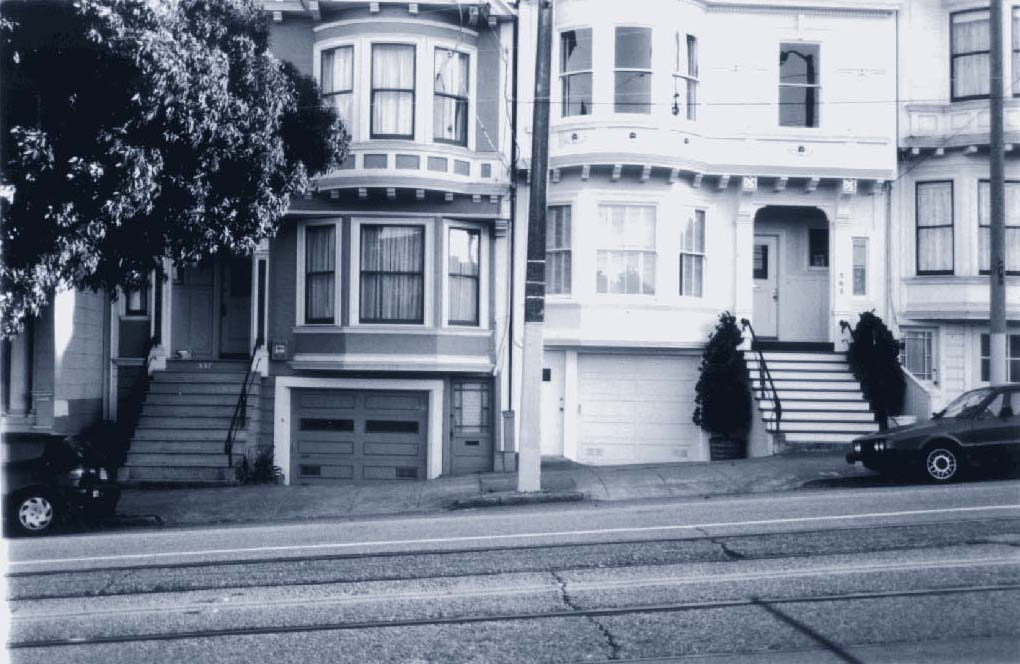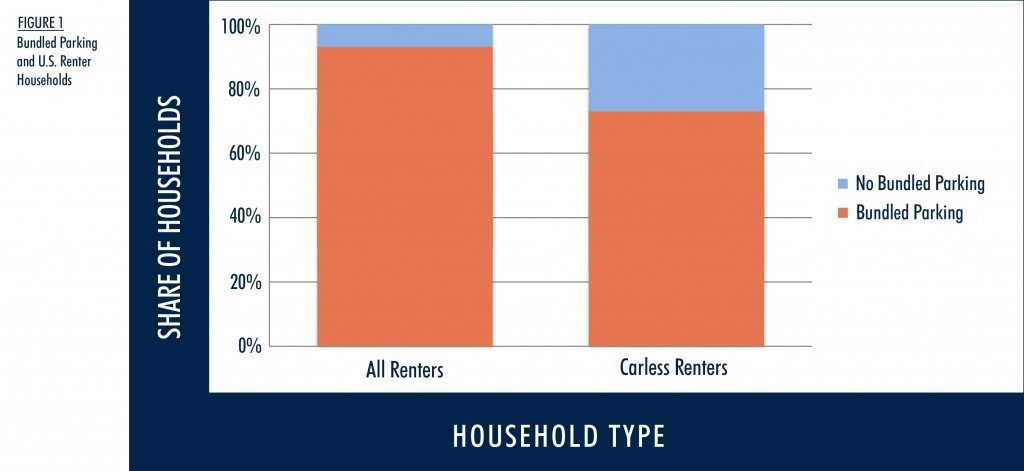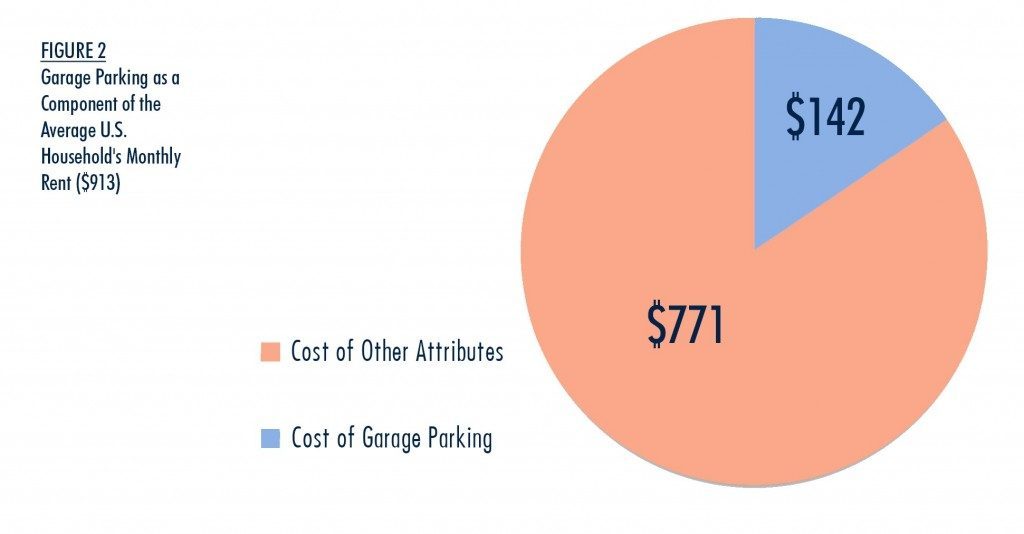C.J. Gabbe, Santa Clara University and Greg Pierce, University of California, Los Angeles
Urban renters in the US face fast-rising housing prices, especially in coastal metropolitan areas. Price increases are in part due to restrictive land-use regulations. Minimum off-street parking requirements, a central component of land-use regulation in the US, warrant detailed study and policy reform. In most cities today, municipal regulation requires developers to provide on-site parking. Renters or buyers then pay for this parking as part of their monthly rent or purchase price; the price of parking is thus “bundled” with the price of the housing unit. While many households might have chosen to pay for on-site parking in a free market, this proportion is surely lower than what has been mandated. Moreover, the historical effect of minimums and bundled parking hides a transportation cost burden in housing prices, leaving households unable to choose. Minimum parking requirements force developers to build costly parking spaces that drive up the price of housing. Urban policymakers have recently taken an interest in reforming parking regulations and allowing unbundled parking based on social equity and environmental sustainability rationales.
In our research, we ask: What are the effects of parking provision on residential rents in America’s cities? We find that the cost of bundled garage parking for renters is approximately $1,700 per year, and the bundling of a garage space adds about 17 percent to a unit’s rent. There are about 708,000 households without a car who have a garage parking space. We estimate that these households’ payments for parking represent a direct deadweight loss to society (a measure of the large-scale inefficiency associated with minimum parking requirements) of approximately $440 million per year. We argue that this figure represents just the tip of the iceberg when considering the indirect cost of minimum parking requirements. We conclude by suggesting two types of local land-use regulatory changes to reduce the high cost burden of parking: (1) cities should reduce or eliminate minimum parking requirements, and (2) cities should allow or encourage developers and landlords to offer unbundled parking options.
Parking Regulation and Housing Prices
Parking regulations limit housing supply, and increase housing prices, by (1) reducing density, and (2) imposing costly standards on developers. Minimum parking standards reduce density when land that would otherwise be devoted to buildings is instead used for car storage. This makes some infill development physically and/or financially infeasible. Minimum parking requirements can also be very costly to real estate developers. Along with the opportunity cost of devoting space to parking rather than another use, there is a high direct cost of building new parking. Nationally, in 2012, the average cost to build one underground parking space was $34,000 and to build an aboveground parking space was $24,000. These costs are ultimately passed on to the consumer whether they have a car or not.
Several city-specific studies estimate the effect of parking provision on housing costs. In a 1999 study, Jia and Wachs found the average single-family unit in San Francisco with off-street parking sold for 12 percent more and the average condo unit with off-street parking sold for 13 percent more than the price of comparable units without parking. In a 2013 study, Manville analyzed a sample of buildings in downtown Los Angeles that had been converted to housing after the city passed its Adaptive Reuse Ordinance. He found that bundled parking raised the rent for an apartment by about $200 per month and raised the price of a condo by about $43,000. These articles provide preliminary evidence regarding the effect of bundled parking on housing prices, but are limited to select neighborhoods within California cities. Building on these studies, we assess how parking affects housing prices among a national sample of housing units.
Using the American Housing Survey to Study the Cost Of Parking
We use data from the 2011 American Housing Survey (AHS), conducted biennially by the US Census Bureau. We concentrate on renters in urban areas because these households are experiencing the worst — and worsening — housing cost burdens. We focus specifically on garage parking because it is the most expensive type of parking to construct and the most prevalent form of parking in central, transit-oriented neighborhoods. Our modeling approach — called hedonic regression — is based on the idea that the price of a house or apartment is a function of its attributes, including building, neighborhood, and locational characteristics. The availability of on-site garage parking is one factor in a household’s housing purchase or rental decision, and is the focus on our study.
Bundled Parking and Renters Without Vehicles
A large majority (83 percent) of rental housing units in American metropolitan areas included some kind of parking on site. About 38 percent of rental units had garage parking, while 45 percent had surface or other non-garage parking spaces. About 17 percent did not have a parking space, but this varied dramatically by metropolitan area. The New York City area had the highest prevalence of units without parking (73 percent), contrasting sharply with Orange County, California at the other extreme (1 percent). Across metros, approximately 3.5 million rental units did not include parking. These units tended to be smaller, older, and with fewer in-unit amenities than units with bundled parking.
Most American households have at least one automobile; census data show that nationwide only about 7 percent of rental households do not have a car. As with bundled parking, there is considerable variation in the share of households without a vehicle across metros, from 26 percent in metropolitan New York City to 1.5 percent in the St. George, Utah, metropolitan area. Across the entire 2011 AHS sample — which includes renter and owner-occupied units — more than 71 percent of carless households live in a housing unit with a bundled parking space, as opposed to more than 96 percent of households with a vehicle. Within our sample of renter-occupied units, these percentages are 73 percent and 93 percent, respectively. Quantifying the relationship between vehicle ownership and parking is important because carless households are paying for something that they most likely do not need or want.
Isolating the Price of a Parking Space
We use a hedonic regression modeling approach and find that a bundled parking garage spot costs about $1,700 per year, or $142 per month. Thought of another way, including garage parking increases the rent of a housing unit by around 17 percent. While these figures were averages for all rental households, we hypothesized that carless renters might place a lower value on parking availability. The data support this hypothesis. For carless renters, bundled garage parking costs an average of $621 a year — a 13 percent premium on their rental price. We calculate the deadweight loss to society stemming from garage parking provided by landlords to residents of 708,000 housing units who do not own a car. At a national level, this deadweight loss amounts to $440 million paid for garage parking spaces unused by residents for parking annually. This amount represents only the direct cost of parking requirements on low-income renters and does not account for the many indirect costs of parking provision.
Discussion
Our results support the economic logic that an apartment with garage parking, with other conditions remaining the same, will be more expensive than one with surface parking or no parking. On the demand side, garage parking spaces are an important amenity for many urban renters. Garage parking is particularly valuable in higher-density urban neighborhoods where on-street parking is metered or difficult to procure. Carless households and households who do not use their garage for automobile parking may still gain some utility from a garage by using it for storage or even additional living space. This would be more likely for households with a private one- or two-car garage, rather than a household with a designated space in a shared parking structure or underground parking garage.
On the supply side, the direct and indirect costs of parking provision are high, and these costs are passed on to renters. Garage parking is expensive to build and its provision often represents a substantial opportunity cost for a real estate developer, particularly when land area is devoted to parking rather than leasable residential or commercial space. We show that these direct and indirect costs are passed on to consumers in the form of higher rents.
The provision of parking supply without associated demand can only be characterized as wasteful. Minimum parking requirements create a major equity problem for carless households, illustrated by the large deadweight loss ($440 million per year) associated with renters paying for garage parking that they do not use for car storage. Given that the carless population in the US is generally made up of lower-income households, many of the households involuntarily paying for garage parking are the ones that can least afford to do so. In fact, we find the average income of households with a garage space but no car ($24,000) is only slightly more than half the income of other households ($44,000). In the absence of paying for an unused parking space, these rent outlays could be applied to renting a larger or better-located unit, other consumer spending, or saving for a home purchase.
Minimum parking requirements create a major equity problem for carless households, illustrated by the large deadweight loss ($440 million per year) associated with renters paying for garage parking that they do not use for car storage.
We recommend that cities should reduce or eliminate minimum parking requirements in urban areas. Even if cities reduce parking requirements, as some have recently done, the housing supply takes years to adjust. It would likely be a decade or two before consumers could choose from many housing options with unbundled parking. Reducing or eliminating minimum parking requirements would have the biggest benefits to renters in higher-density, centrally located neighborhoods where garage parking is prevalent.
We also recommend that cities allow or encourage real estate developers to unbundle parking from new housing. This recommendation depends on reform of minimum parking standards. If minimum parking standards are not reduced or eliminated, a developer would have little or no incentive to unbundle parking because there would be an oversupply of parking that could not be rented, and a developer would essentially pay for this. A combination of these policies will allow developers to build housing with less parking and then to use pricing to allocate the parking spaces they construct as they see fit.
Conclusion
Our findings provide the first nationally representative evidence that urban garage parking provision is costly to renters. We provide further evidence that minimum parking requirements are burdensome to renters and lead to societal waste. Carless households, many of whom have low incomes, are disproportionately affected in neighborhoods and cities where garage parking is the norm. Eliminating minimum parking requirements in these locations will allow the market to gradually meet the latent demand for housing options with unbundled parking. Additionally, it will reduce the annual $440 million deadweight loss directly experienced by urban renters without cars. In short, the elimination of minimum parking requirements will help remedy the perverse incentive for driving and discourage the sprawling urban form that these requirements have encouraged over the past 75 years.
This article is adapted from “Hidden Costs and Deadweight Losses: Bundled Parking and Residential Rents in the Metropolitan United States,” Housing Policy Debate (2017) 27: 219-229.
References And Further Reading
Wenyu Jia and Martin Wachs. 1999. “Parking Requirements and Housing Affordability: A Case Study of San Francisco.” Transportation Research Record 1685: 156–60.
Manville, Michael. 2013. “Parking Requirements and Housing Development.” Journal of the American Planning Association 79 (1): 49–66.
Donald Shoup. 2014. “The High Cost of Minimum Parking Requirements,” in Parking Issues and Policies, edited by Stephen Ison and Corinne Mulley. Bingley, UK: Emerald Group Publishing, 87–113.
Donald Shoup. 2011. The High Cost of Free Parking. Revised edition. Chicago: Planners Press.
Suggested citation for this article
Gabbe, C. J., & Pierce, G. (2017). The hidden cost of bundled parking. Access, 51(Spring). Retrieved from https://www.accessmagazine.org/spring-2017/the-hidden-cost-of-bundled-parking/








